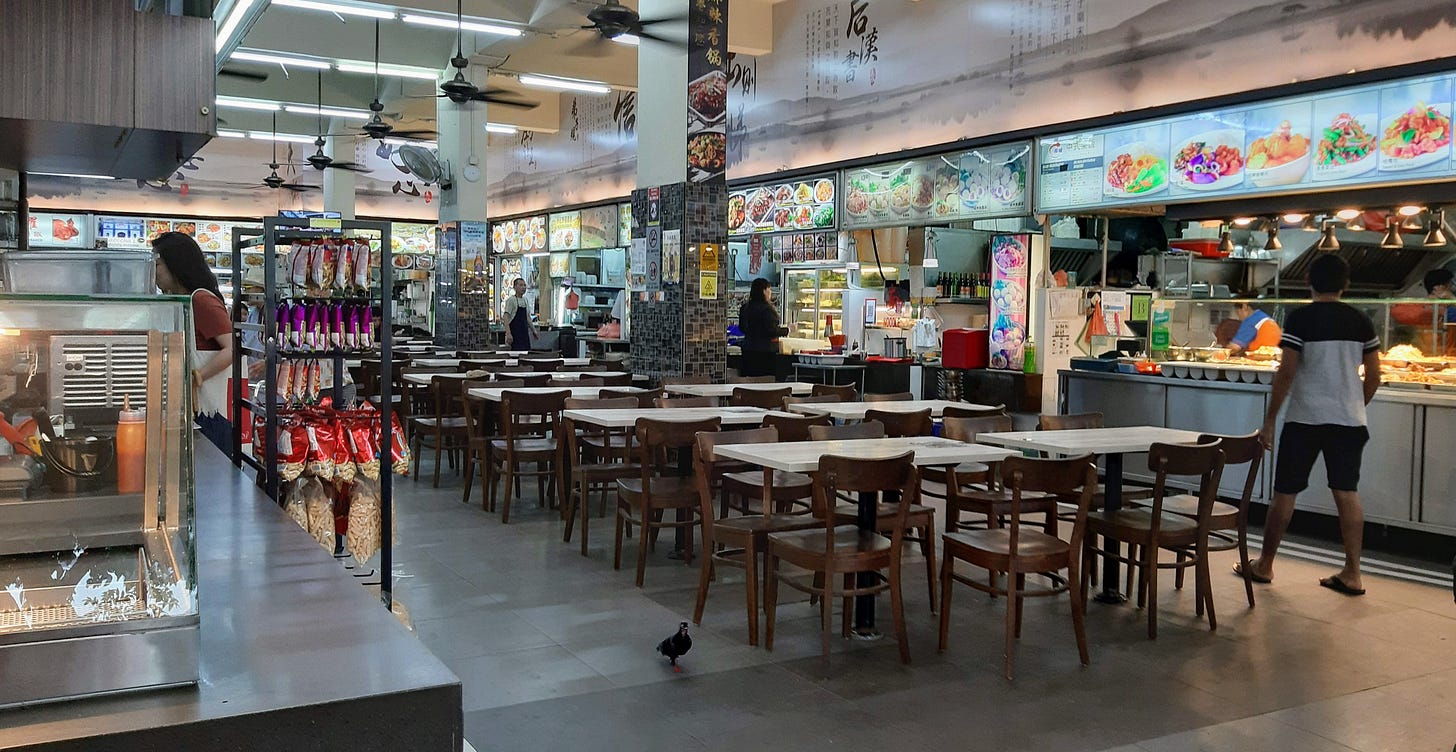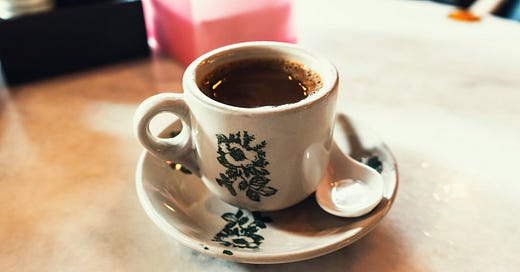2018 was a big year for me….
It was the year I set aside my legal career of almost thirty years, the year our nest cleared out, and the year my husband and I moved our empty nest from New Jersey to Singapore for his job. With no set agenda, a keen sense of curiosity, and an amazingly bad sense of direction, I embraced the adventure. And I began to write, sending my words out into the world.
The essays I publish here on Substack are a continuation of that journey. But wait, as they say, there’s more! Since we returned to the U.S. in 2020, I’ve also been crafting a collection of essays about my experiences in Singapore. Like the essays in Age of Enlightenment, they come with a sprinkling of humor. (I’m a firm believer everything’s better with sprinkles.) I thought you might enjoy a taste. Imagine it’s a new ice cream flavor (still with sprinkles!), grab a spoonful, and let me know what you think!
When it comes to ordering coffee in Singapore, I’ve got plenty of options. I could go to that place where you order your American coffee in Italian. Singapore has plenty of those, and plenty of other chains where I could order my coffee and feel like I never left home. But I live here now, and feeling like I left home is exactly what I want. I want a simple cup of coffee, Singapore style.
Therein lies the challenge and the opportunity. In Singapore, a former British colony, English is the lingua franca. There’s almost nothing I want, need, or crave on this island that I can’t get by speaking English. I’ve been ordering my Singaporean coffee in English, too – coffee, milk, no sugar – which is all well and good, but it’s skating on the surface. If I want to order my coffee like I live here, I’m going to need a word or two of Malay. Possibly a few words of Chinese dialect. This makes the prospect of ordering a proper cup of Singaporean coffee both terrifying and exhilarating. As a shiny new expat, that’s exactly what I want.
In our family, my relationship with languages beyond the realm of English is legendary. I’m the optimist who continues to believe, all experience to the contrary, I can learn a new language before every trip. I usually manage to master the basics – hello/goodbye, please/thank you, bathroom. I try to include a few “essentials” I’ve learned are worth the effort – foods that don’t agree with me anymore (I miss you, eggplant!), activities requiring liability waivers (bungee jumping?!?), and parts of animals I prefer to avoid (sweetbreads?!?!?). But please don’t ask me actually to say anything. That’s the moment everything I’ve “learned” evaporates, when all I can do is smile, point, and (worst of all), mime what I want. In my family, the phrase “Mom’s fluent in [insert language of your choice]” isn’t a statement. It’s a long-running joke, followed by (in order) eye rolls, giggles, and pretending not to know me.
That’s not gonna fly if I want to order my Singaporean coffee like I live here.
What, you might ask, is so special about Singaporean coffee? For starters, it’s an amazingly sturdy drink. Best served, in my opinion, in a thick, ceramic cup I’m convinced is specially designed to stand up to the coffee it contains. (Glass is common too, but it doesn’t feel the same.) Some of that sturdiness may be due to the beans (high-octane Robusta). It might also be due to how the beans are roasted – in butter and sugar, a tradition that began as a way to compensate for the cheaper beans used in Singapore’s original coffee shops. It might also be due to the fact that the coffee is brewed in a sock. (Okay, a sock filter.) Whatever the reason, the result is a coffee that’s a lot like Singapore – energetic, complex, and punching well above its weight.
But there’s something else. Unlike the venticappumochalatte you might order at the other place, where you’re responsible for adding your own milk and sweetener, nothing about Singaporean coffee is self-serve. A legit cup of Singaporean coffee is prepared for you, when you order it, the way you order it. Which means, of course, you have to know how to order it.
The baseline is kopi (Malay for “coffee”). But kopi isn’t just coffee – it’s coffee with sweetened condensed milk. If you prefer your milk unsweetened, you’ll be wanting kopi C (which comes with evaporated milk – and sugar, but hold that thought). Yes, “condensed” starts with “C” and “evaporated” doesn’t, but don’t let that Confuse you. Some say the “C” is for Carnation, a popular brand of evaporated milk. But Carnation also makes condensed milk, so there goes that theory. More likely, the “C” is shorthand for xiān, Hainanese for “fresh,” recalling the days when a can of evaporated milk was the freshest cow juice available on the island. If all this feels like a lot, you can go for kopi O, which has no milk at all – but still includes sugar. So let’s talk sugar. I try to avoid it, so my sugar choice is kosong (Malay for “empty,” aka none). There’s also siew dai (Cantonese, meaning “less sugar”) and gah dai (also Cantonese, meaning “extra sugar”).
The preceding paragraph may feel like a mouthful, but I’ve actually kept it simple. It’s complicated stuff – not quite “assembling something from Ikea” complicated, but complicated enough. And I haven’t even touched on the other options, like strength, ice, or (the Holy Grail) a pat of butter. There are literally dozens of ways to order a cup of Singaporean coffee. If I learned them all, the vocabulary I’d acquire would exceed anything I retained from the five years of Spanish classes I took over forty years ago. (The bar is low, but still….)
To order a proper cup of Singaporean coffee, you need to go to a kopitiam. And, no surprise, kopitiam is a mix, too – kopi, as we’ve discussed, is Malay for “coffee,” while tiam is Hokkien for “shop.” But don’t let the term deceive you. Kopitiams aren’t just for coffee. They’re smallish food courts, they’re seldom air-conditioned, and they happen to be great places for coffee. Every kopitiam has a drink stall (usually just one), and it’s the drink stall that rules the roost.
Our favorite kopitiam fits the bill – a drink stall up front, whirling fans, open to the sidewalk. A perennial pair of elderly Chinese “uncles” in white singlets and baggy shorts sit in a corner, one bare foot on their chairs and their chins on their knee, shout-talking over cigarettes and bottles of Tiger Beer. Beneath their table, a pigeon is perpetually poised, ready to chase anything that might fall to the floor. Nearby, an ever-present, elderly “aunty” alternates between slicing vegetables and jumping into the conversation.

The day I step inside to order my first proper cup, the characters are all in place. Shout-talking uncles? Check. Poised pigeon? Check. Vegetable-chopping aunty? Check again. And me? I break out in a pool of flop sweat. To be clear, flop sweat in Singapore isn’t much different than everyday Singapore sweat, except, perhaps, in quantity and origin. All I want is a simple cup of coffee. Kopi C kosong. But in the moment, I’m terrified at the prospect of saying the words out loud – and mangling them.
I whisper the words like a mantra (kopiCkosongkopiCkosongkopiCkosong), dreading the moment they’ll leave my mouth and enter the world. It’s Monday. Who orders coffee on a Monday? Something flits by, just out of the corner of my eye. Is that another pigeon? (It is.) If I don’t place my order soon, my head might literally explode. Inside a kopitiam. In front of some shout-talking uncles and a vegetable-chopping aunty. And a couple of pigeons.
I step up to the drink stall, hold my breath, and wait for the woman behind the counter to look my way. KopiCkosongKopiCKosongKopiCKo—
We have eye contact.
“Kopi C kosong.” “Please,” I add. And I smile. (A smile always helps.)
The woman doesn’t smile back, and I’m sure I’ve screwed up my order. Which would be more humiliating, I wonder – repeating my order in mangled Malay, giving up and ordering in English yet again, or miming the concept of “evaporated milk, no sugar”? She continues not to smile, but she nods and gets to work. A minute later, a ceramic saucer clinks on the counter. And there it is.
Kopi C kosong. I hope.
I carry my coffee to a table near the sidewalk, lean back into my chair, and watch the morning unfold at the kopitiam. Even at breakfast, the air is thick with shouted orders and sizzling woks. But not as thick as my coffee cup. And definitely not as thick as my coffee.
Beneath a nearby table, a couple of well-fed pigeons take it all in. From my seat on the perimeter, so do I. I wrap my hand around a simple cup of coffee that’s everything I want my expat experience to be. Intriguing, enticing, inscrutable – and, yes, a little nerve-wracking. My simple cup of Singaporean coffee doesn’t invite me to get to know it so much as it dares me to try. I take a sip. It’s perfect.






The shouting uncles. The veg chopping auntie. The pigeon...perfect.
Love this line; "flop sweat in Singapore isn’t much different than everyday Singapore sweat, except, perhaps, in quantity and origin."